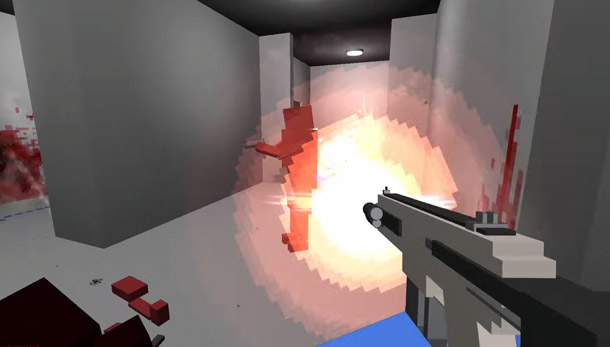Due Process hands-on: kicking down doors in low-fi Rainbow Six

The last thing I played at PAX earlier this month was Due Process, a tactical FPS in development by Seattle-based Giant Enemy Crab. Though it's very much in a primordial state (pre-alpha, by the dev team's description), Due Process ended up as one of my highlights from the show simply because it's exciting to see an indie team explore a genre that's typically reserved for big studios.
But wait, why would I want to play a low-budget, indie take on Rainbow Six when Siege (our favorite game of E3 2014) is on the way? For the same reason I'd play something like Torchlight or Path of Exile over Diablo III: creative, interesting stuff tends to happen when a studio has to design a game under constraints. For one thing, Due Process' minimal, feature-light approach means it's visually very easy to decode, a quality I look for in any competitive shooter. The art is clean and Minecrafty, with early '90s diskettes, VHS tapes, Xerox machines, and office junk cluttering simple floorplans. The characters will get textures wrapped around them eventually ("We're not going for 'red versus blue,' producer Neal Doherty told me), but in the meanwhile, without much of a glaze to sugarcoat it, Due Process does fine on its mechanics alone.
The setup is classic attack-and-defend, with the four players on each team swapping halfway through the match. In the current build, the attacking side (a SWAT team) has more (and more powerful) gear that they pull off weapon racks: flashbangs, nightvision goggles, riot shields, breaching charges, and rifles that have better range than the current SMG and pistols available to the defenders. But this asymmetry is balanced cleverly: if the defenders survive, they can steal equipment that they retain for later rounds. And the attackers only have, say, eight flashbangs and a few frag grenades to use through an entire match. If they spend them all in the first round, the defending team can draw up a plan knowing that they won't get grenaded in the second or third round. The design of this feels a bit like iterating on your tactics in Counter-Strike but in a very condensed format.
The lower fidelity also makes possible Due Process' best feature: random level generation. The first minute or so of each round is reserved for planning and sketching in a top-down blueprint view of the map, the layout and features of which are distributed differently each round. It's terrific to have planning integrated as a phase like this, and I love the way how fundamentally important communication and planning are from the outset.
Levels barely amount to a few hundred square feet of floorspace, but that design feeds into the overall concentrated feel of Due Process. It's surprising how much good tactical decision making and planning can some out of such simple maps. At one point, playing defense, my team recognized an entry point that would be way too attractive for the attackers to pass up: an isolated alcove with the electrical box nearby, where they could enter and quickly cut the lights on the map. Defending that electrical box became our singular goal, and we pointed all of our guns into that little alcove, hoping to shoot anyone down before they could flip the switch. The defending team in the current build doesn't have flashlights or nightvision, so cutting the electricity puts them at a huge disadvantage.
Due Process has its basics down, but the hard part will be gently adding complexity without disrupting its hyper-distilled formula: short rounds, frantic gunfights, and compact spaces that are easy to memorize before entering. There's a ton of stuff that Giant Enemy Crab could add to this project—more gadgets, new room types, character classes—but what'll define Due Process is what's left out.
The biggest gaming news, reviews and hardware deals
Keep up to date with the most important stories and the best deals, as picked by the PC Gamer team.

Evan's a hardcore FPS enthusiast who joined PC Gamer in 2008. After an era spent publishing reviews, news, and cover features, he now oversees editorial operations for PC Gamer worldwide, including setting policy, training, and editing stories written by the wider team. His most-played FPSes are CS:GO, Team Fortress 2, Team Fortress Classic, Rainbow Six Siege, and Arma 2. His first multiplayer FPS was Quake 2, played on serial LAN in his uncle's basement, the ideal conditions for instilling a lifelong fondness for fragging. Evan also leads production of the PC Gaming Show, the annual E3 showcase event dedicated to PC gaming.

Amazon's Mass Effect TV show now in 'active development' from the writer of F9: The Fast Saga (the one where a car goes to space)

Take-Two CEO says Grand Theft Auto 6 is on track for 'fall' next year, GTA 5 has sold over 205 million, and 'PC will be more and more a part of [our] business going forward'
Most Popular

